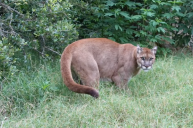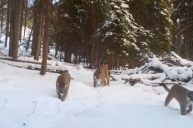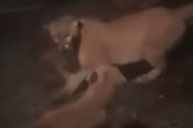Researchers revealed in a study published this week they discovered the first case of a mountain lion in the U.S. contracting a deadly neurological disease in cats. In Tuesday's announcement, Colorado Parks & Wildlife officials said it's the first documented case of the rustrela virus, or "staggering disease."
In a statement, Dr. Karen Fox, a CPW wildlife pathologist who served as lead author for the paper, explained that they don't really know how the virus spread to the animal. They also don't know if there are more cases. The upside, however, is that they now have the tools to identify the disease.
"Now that we know what we're looking for, it should be easier to find new cases if they are out there," Fox said. "With continued collaboration, we plan to learn what we can from our colleagues in Europe while we continue to look for new cases of staggering disease here in Colorado."
Officials encountered the disease in May 2023, when they had to euthanize a sick mountain lion that lost the use of its hind legs. Video of the infected mountain lion shows it struggling to walk and dragging its hind legs. Over several seconds, the animal barely walks five feet.
After euthanizing the animal, Fox explained that officials tested tissue samples and found the infection. However, they needed help from researchers from the Friedrich-Leoffler-Institut in Germany as the disease primarily infects cats in Europe.

Video of the mountain lion infected with staggering disease in May 2023. Credit: CDC
How to identify staggering disease
In its guidelines, the European Advisory Board of Cat Diseases explained that "staggering disease" causes a staggering gait, hind leg ataxia, and other neurological issues in cats. While the virus mostly infects cats in European countries, there have been reports of rodents, a donkey, and marsupials infected by the disease.
Veterinarians with CPW and Colorado State University said they will be looking carefully for new cases of restrela virus. In turn, they are asking the public if you see a mountain lion staggering or having trouble walking or behaving abnormally to report it to state wildlife officials.




